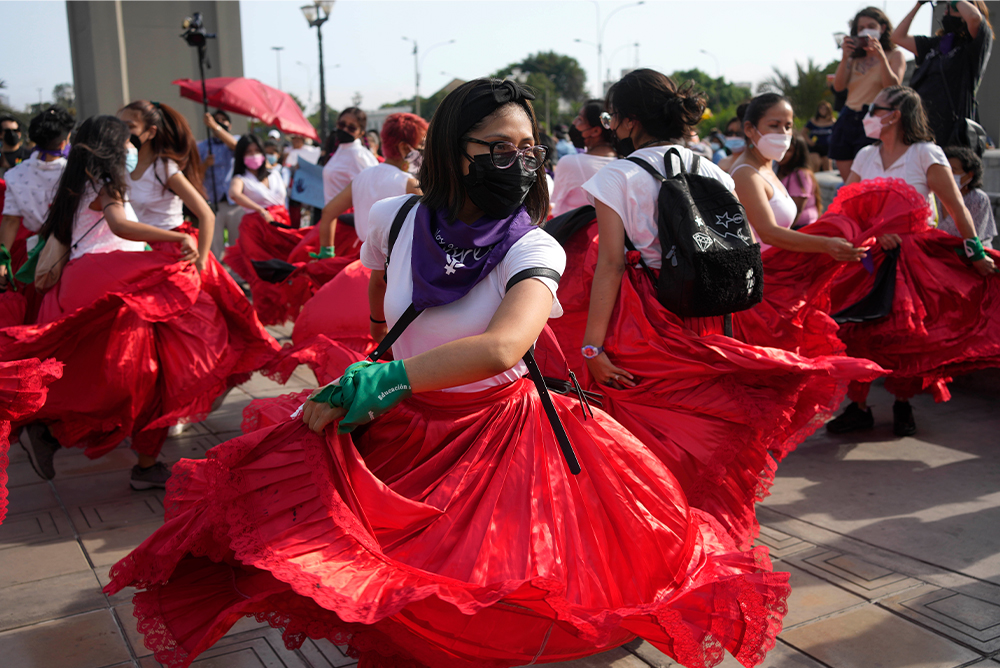
Peru is facing the worst institutional, political, and social crisis of its recent democratic history. Political reformer Nadia Ramos explains how affirmative action efforts can help. Courtesy of AP Newsroom.
What are the obstacles and opportunities facing democracy today? Zócalo is publishing a series of letters to highlight how the world’s democratic ideals are faring in practice. From Peru: Nadia Ramos, CEO of the Women’s Leadership Center of the Americas, writes about efforts to achieve parity for women in politics, and why they can help a nation in democratic crisis.
Can affirmative action save Peru?
Peru is facing the worst institutional, political, and social crisis of its recent democratic history. In December, then-President Pedro Castillo dissolved Congress, a decision that led to his arrest and ouster. Replacing him with the first vice president, Dina Boluarte, in turn, sparked protests, and then, a deadly government crackdown.
Behind the conflict lies a deep division. For years, Peru was described as democratic—but democracy, and prosperity, were experienced only in and around Lima, the country’s capital. People in the provinces felt underrepresented and excluded. The pandemic only made things worse, highlighting the lack of access to health and education outside the capital.
Today, Peruvian people are demanding the end of that division—and they’re being met with repression, violence, criminalization, and human rights violations. We in Peru live with all of this, plus the political uncertainty that fragments our society’s already weakened institutions.
What is the way out of the escalation of conflicts and confrontations? The fair and reasonable agenda of people in the provinces deserves respect, not reprisals. We need a deep rethinking of centralization in politics, and in government services. And urgently, the executive, and legislative branches—and our elections—all require major reforms. We must focus on affirmative action to bring balance back to Peru so that local communities are on the same level as the powerful and rich people in Lima.
Peruvian politics has long been characterized by unrepresentative political parties that are often tied to unrepresentative regional movements. That centralized system has made the government permeable to corruption. It also has discouraged political participation, particularly of women and underrepresented groups and communities.
My work with civil society groups promotes pending political reforms that will explicitly include Peruvian women in decision-making roles and on the electoral lists of our parties. It’s important to have specific guarantees of substantial representation to become a true democracy.
These are not new demands, and reform is not new work here.
Back in 2010, women’s and feminist groups promoted initiatives that sought gender “parity and alternation” in political meetings, requiring government bodies to have equal numbers of men and women present. Parliamentarians, leaders of political parties, civil society groups, and citizens worked together over several years to design such proposals. But parties registered objections with Peru’s Congressional Commission on Women and Family, and the ideas could not become reality.
Noting this opposition, in 2016, my organization began a round of visits to parties, regional movements, community leaders, civil organizations, and other political actors spread out across 18 out of Peru’s 25 departments, or administrative regions, to discuss creating gender quotas for meetings and public consultations. We took advantage of four electoral contests between 2016 to 2019—including municipal, regional, and general elections—to make our case.
We began to achieve victories. In 2019, the country’s first parity and alternation law was approved. It was to be applied in stages: 40% percent women on party lists in 2021, 45% in 2026, and 50% in 2031. The law required that electoral bodies and the country’s official ombudsman analyze the new measures to see if they were promoting the participation of women in politics.
Subsequent laws and amendments have extended the gender requirements to the list of candidates for the presidency—in which the president and two vice presidents are chosen—as well as to the lists for subnational elections, and positions of the leadership of the political parties. But in practice, the legislation has not produced parity in elected bodies because parties and regional movements have interpreted the laws differently, and used mechanisms to avoid full parity.
Today, civil organizations are pushing to make these previous laws enforceable, while also pushing for additional electoral reforms. Beyond gender parity, we also need democratic mechanisms to encourage a better relationship between voters and political parties, which must find new ways to relate to their constituents.
Peruvian politics should unite collective interests and avoid channeling only those that represent individual and clientelist (or patronage) demands. It should look beyond Lima.
The present crisis in Peru presents new challenges, but also the hope that change must come. And that we will not only have parity for women politicians but the full representation that our country, and our democracy, requires.




Send A Letter To the Editors